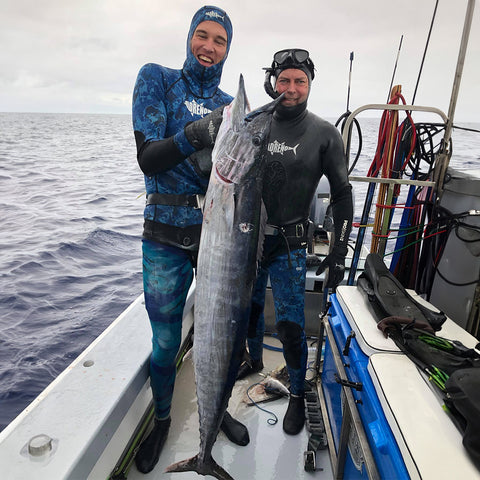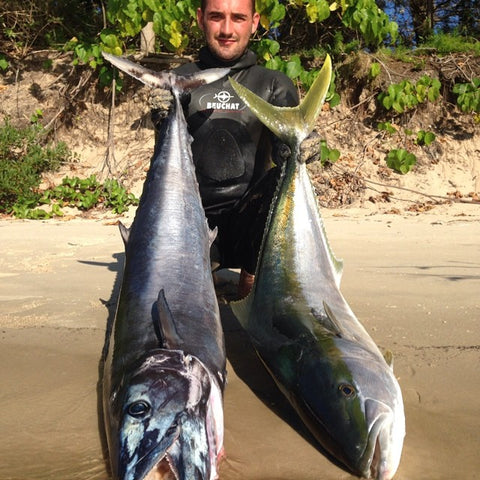Spearfishing Wahoo
July 27, 2023 6 min read

The incredibly fast and strong Wahoo is a great-eating pelagic fish pelagic fish that is known for putting up a good fight, capable of testing the skills of even the most seasoned spearo. Whether you're just starting out or a seasoned veteran, there's always a thrill in chasing wahoo.
Wahoo can reach speeds of up to 97 km/hr, making them one of the fastest fish in the sea. It's no wonder spearos consider them gear testers, as having the right spearfishing equipment is crucial to landing these swift creatures. Not only are they incredibly fast, but they can also grow to an impressive size, with some specimens reaching up to 2.5 meters in length and weighing as much as 83 kilograms!
To embark on a successful Wahoo spearfishing trip, you'll need to focus on location, patience, dive buddies, and, most importantly, top-notch gear. Follow along to learn what you need and how to execute this thrilling hunt.
Step 1. Gear for Spearfishing Wahoo
When it comes to spearfishing for wahoo, having the right gear can make all the difference! To increase your chances of landing this speedy fish, we recommend using a rig line and small float setup to give the wahoo room to run and reduce the risk of the shaft tearing out of its soft flesh. Don't forget to bring flashers and burley to keep the wahoo within shooting range. Wahoo are known to be gear testers, so investing in good equipment is crucial. Opt for a 1.2m - 1.4m speargun with twin 16mm rubbers and a 7mm - 7.5mm shaft for the best results. For a comprehensive guide on spearfishing gear, check out our gear guide here.

Jacob Lambert (Ecommerce) & Tim Neilsen (Founder), in Tonga.
Step 2. Finding Wahoo
You're most likely to find Wahoo in the autumn months, such as May-June or even late spring, from October-November when the water is around 22.5-24.5 degrees Celsius. They are commonly speared in the Brisbane area around North Stradbroke and Moreton Island. However, due to their tropical nature, these species can also be spotted within the Southern Great Barrier Reef, specifically in the Bunker Group, as well as in Western Australia from Rottnest Island, spanning across the Northern Territory and extending as far south as Montague Island in NSW. Like most Pelagic fish, if you find the bait, it's only a matter of time before the big fish start coming in.
Wahoo can be found relatively close to shore and in water as shallow as 8m; however, they are most typically hunted as a bluewater fish on seamounts or deep reef edges. FADs and other floating debris also attract Wahoo. Finding some good current is also key to increasing your chances of finding a Wahoo. For Brisbane Spearos, you'll generally find the current runs from North-West to South-East off the coast, so you'll want to find a nice spot with around 20-40m of depth where the movement is strong. If Wahoo aren't already hanging off the back of your boat, jump in about 400m up current in slightly deeper water and drift down. Patience is key when spearfishing Wahoo; if you have all the stars aligned, it's only a matter of time before the Wahoo starts rolling in. Sometimes, depending on your local knowledge and experience, it can take a few years to successfully find and take home a Wahoo without having them spook, tear off the spear, or get sharked before you finish for the day. They're also regarded as solitary species, so making the first shot count is important for the success of a dive.
You will find Wahoo typically in the first 5m of the water column, making them a fish that can often be easy to get a decent aim at. However, the moments just before and immediately after taking the shot are generally the most difficult and important.

Sam Cox (General Manager)
Step 3. Hunting & Spearing Wahoo
Like any fish, Wahoo can range from being easy to shoot to being extremely shy and elusive! It really depends on the individual fish.
If you are hunting for Wahoo, you will typically want to be in good visibility, using burly and flashers to spike their interest and lure them in closely. Wahoo is a very inquisitive fish but can be easily spooked, so always act disinterested, avoid direct eye contact, and never rush at the fish.
Although it may be tempting to spear the Wahoo from the surface, try to take a small breath and slip silently below the surface 1m or so to ensure that the aim is not interrupted by any surface swell or chop. Wahoo is a large fish, and often spearos can be deceived by how far they actually are; consequently, taking the shot too early can have the spear fall short of the fish or fail to fully penetrate. A good rule of thumb when hunting Wahoo, or any fish in clear water, is to take a few extra kicks toward them before you take your shot.
Once shot, it's important to keep the line under some tension as the Wahoo can accelerate quickly up to 100km/hr, and any slack in the line will most likely result in you losing your catch. Too much tension or getting caught on a dive buddy's float will end in heartbreak though - Wahoo has soft flesh and will tear through easily. Although Wahoo is relatively easy to shoot, it can take a spearo years of experience to finally land one.
As you pull in the fish, they'll tend to circle you as they get closer. If you have a good holding shot, they should be easy to control, but be sure to feed the line away from you to avoid entanglement.
As soon as the Wahoo is within grabbing distance, grip the tail and flip them belly up – this will calm the fish and almost instantly put it to sleep. You then want to get your hand into its gills. While the Wahoo is under your control, make a quick cut to the gills and brain the fish. This will ensure the catch is dead and reduce the risk of a run-in with its razor-sharp teeth.
An important tip, too, if you're chasing any bluewater fish, is to make sure you've got a good system worked out with your dive buddy so that you're not swimming over each other's float lines. There's nothing more heartbreaking than losing a good fish due to a preventable tangle of floats, or worse, getting dangerously tangled yourself! Consider having one person work the flasher with a reel gun, and only one float line in the water with the primary shooting gun - work in a team, taking turns as the shooter or flasher.
If you want a photo of your prized catch, you're going to want to take the photo fast as blue stripes fade to grey almost immediately after its death.

@jessie_cripps_sv_popao
Shooting Technique for Wahoo
Where to shoot a Wahoo is a matter of personal preference.
Some prefer to spear them in the tail between the anal and dorsal fin, as this slows the Wahoo down somewhat and, being a high bone-density area, can also provide a good holding shot.
However, if you're a skilled shot, aim for a head shot, as Wahoo are known to be quite easy to stone dead. Aiming just behind the gill at eye level is generally a great spot to stone or hold the fish. It's also helpful to observe the fish's anatomy as you fillet it, as this can give you a better understanding of the ideal spots to aim for.
If you are going for the headshot, keep in mind that the large gut cavity of the fish is located near the head, and spearing this will definitely result in losing the fish, and the fish dying.

Sam Cox (General Manager)
Step 4: Care / Recipes
Wahoo are considered a great eating fish. In fact, in Hawaii, they are called 'ono,' which translates to 'tasty.' The flesh of the Wahoo is white, delicate but firm, and highly regarded by many gourmets. The taste is similar to mackerel, though arguably less pronounced.
This has created some demand for the Wahoo as a premium-priced commercial food dish. Despite the demand, Wahoo as a species is not considered overfished as they are not affected by heavy commercial fishing operations, due to the fact that they do not school together in large numbers like the Tuna.
Wahoo is great steaked, seasoned, and grilled on the BBQ with fresh salad or vegetables. They also make some of the best sashimi around.
Check out some of the recipes here:
1. Sashimi- Enjoy Wahoo in it's most pure form!
2. Carpaccio - How to make Carpaccio with Wahoo
3. Ceviche- This famous dish is great for most Pelagic fish!


